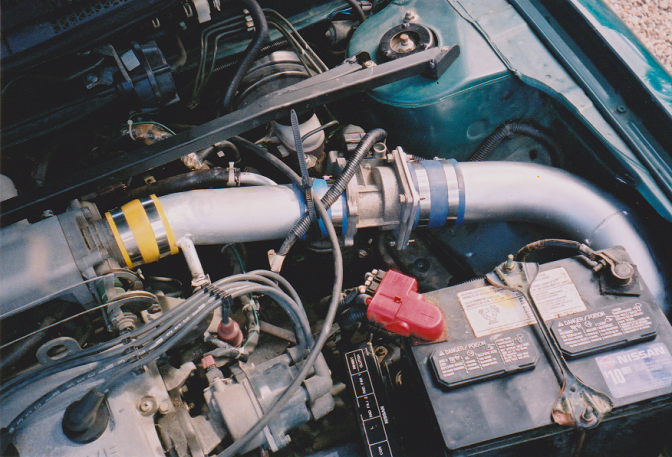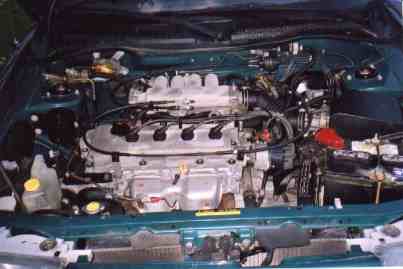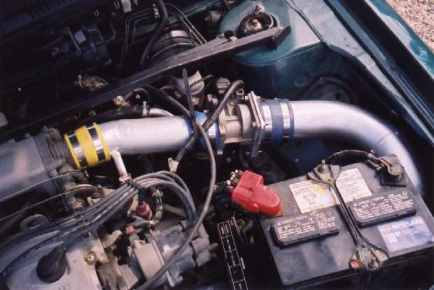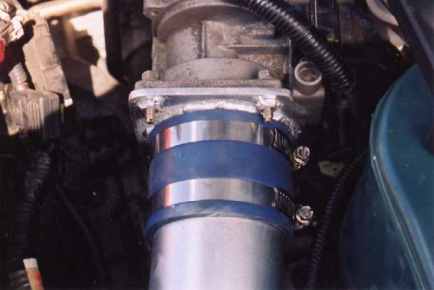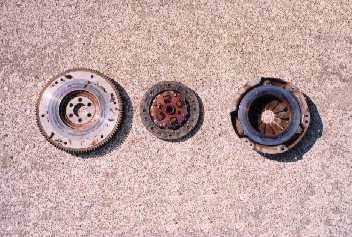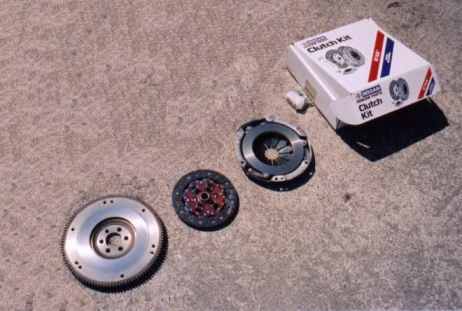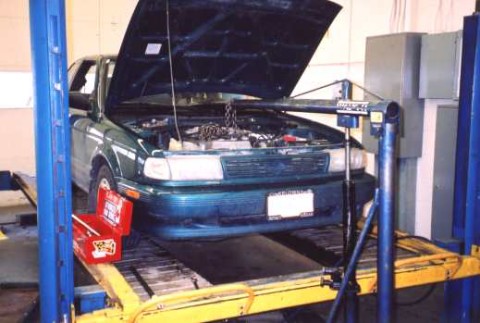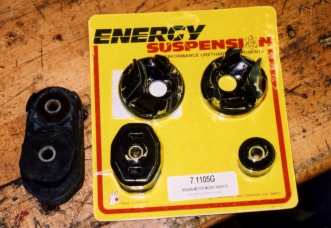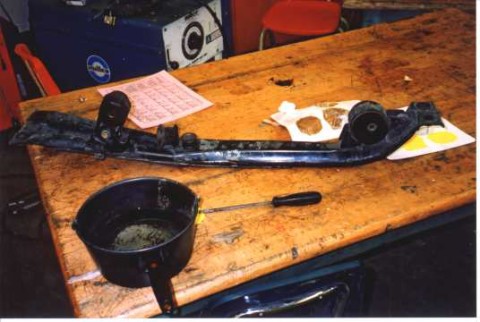[ Start ] [ Wheels & Tires ] [Bushings ] [ Springs & Struts ] [ Sway Bars ] [ Alignment ] [ Drivetrain ] [ Miscellaneous ] [ Racing ]
This Nissan Sentra is equipped with the GA16DE, 1.6L twin cam 16 valve, variable valve timing, multi-port fuel-injection engine. It has a 5-speed transmission, and is essentially unmolested internally.
There are a few drivetrain modifications I can legally do within CACC F/SS rules, but in autocross racing, money is best spent on the suspension first, then on the drivetrain.
I am not permitted to perform any internal engine modifications, nor am I allowed to change any gear ratios in the transmission. I will endeavour to provide information as I find it on the B13 drivetrain, whether or not I use it.
Ignition Timing
Based on my experience with the Heinous Honda, most traditional ignition modifications made no noticeable difference in performance.
Advancing the distributer a few degrees seems to hold much favour from the Sentra crowd. I decided to try it, and advanced the distributer to 15° BTDC. There was somewhat of a noticeable improvement over the original setting (10° BTDC), but I have no personal numbers to back it up. Dyno tests have shown a few horsepower gains on this engine.
Although most people would run premium fuel when they advance the timing, I found that I was able to get away with running 89 octane with no detriment to running. I had been running 87 octane for a number of years, and then noticed ever-so-faint knocking on hills in the summer. I believe that if an engine does not need a higher octane fuel, you are wasting your money by buying it. An engine will get the most power out of the cylinder pressure it can build with the lowest octane it can burn without knock or ping.
Setting Timing
|
Spark Plugs
Everyone has their favourite flavour of spark plugs. I’ve always been a big fan of NGK plugs. No particular reason why, I guess I just like the feel of them. The OEM spark plugs were NGK platinums (G-Power), so I bought those on sale at Canadian Tire. Compared to the worn NGK V-Powers when I bought the car, the car started easier, ran smoother and made me smile.
I’ve since changed to Autolite Iridium spark plugs after 100,000km’s on the NGK Platinums, and noticed no noticeable difference.
Engine Oil
I am a big fan of running quality oil, and frequently changing it.
I’m also cheap.
Canadian Tire‘s top of the line “Motomaster Formula 1” oil comes in three flavours: petroleum-based, synthetic blend, and full synthetic. I ran the Formula 1 petroleum-based 5W30 (one litre low) for years in the Heinous Honda and was quite happy with it. It “feels” nice (yes, that’s a subjective analysis of the product).
For the Sinister Sentra I upgraded to the Formula 1 “Synthetic Blend” 5W30. Not quite as expensive as full synthetic, but considering how frequently I change the oil, I think it’s a reasonable substitute. Some argue that the whole point of running synthetics is to lengthen the service interval. My argument is: Why? Why bother lengthening the interval? Clean oil is your friend – change your oil frequently, it’s cheap insurance.
| ENGINE OIL Engine Oil Capacity with filter: 3L Oil Change Interval: 4000km |
Cold Air Intake
One of the first goodies people like to add to their car is a “Cold Air Intake” (CAI). This device takes the engine air inlet out of the engine compartment and places it into an area of cool air.
The idea is that the cooler you can make the incoming air charge, the more dense the charge, thus there is more oxygen by volume ingested. This should make us more power. CAI’s have proven to provide a few more horsepower on the Sentra, in the neighbourhood of 4-5hp. Not much, but every little bit helps, I guess.
Most of the reputable CAI’s retail around $400 CDN (2002), such as the Place Racing and Hot Shot intakes. Since there are so many documented installs on the internet, it is relatively easy to manufacture your own knock-off.
I made my own Cold Air Intake with the following:
| DIY CAI $24.00 – two 2 1/2″ silicone couplers $12.00 – 3″ silicone coupler $40.00 – K&N “POP-Charger” knock off $25.00 – 3″ mandrel-bent “U” $10.00 – Assorted scrap metal$111.00 – Total |
The most difficult part was fabricating the Mass Air Flow (MAF) adapter, as the factory mount could not be adapted to a CAI. I used 1/4″ steel plate, drilled to fit the MAF bolts, then turned to fit a 2″ wide section of 3″ tube. Ironically, the inlet of the MAF is just smaller than the inside diameter of the 3″ tube – nice!
One thing I did not fabricate was a mount for the MAF to prevent it from flopping around as the engine moves. This would be a good idea, and I will make one at some point.
I had to remove the battery to snake the 3″ tube between it and the inner fender. I enlarged the factory hole to fit the tube through, and the filter attached to the end, now behind the front bumper, in front of the front wheel.
The engine is much, much throatier under wide-open-throttle (WOT). The intake has a very distinctive sound, more deep in tone than many other intakes I have heard. At first I really didn’t like the sound at all, but the more I drove the car, the more I started to like it. It’s very throaty – people keep asking me what I’ve done to the engine!
Did it make a difference in power? Not at low speed. Up past 4000rpm it “seems” more powerful, but I don’t have numbers to back it up. It feels as though it is more free to rev – not so “stifled,” but sound always gives the illusion of power. Nevertheless, CAI’s have been dyno’d and documented to produce more power on a 1.6L Sentra.
One thing that came up again and again among the Sentra crowd is the risk of ingesting water when driving a CAI in the rain. Personally I think the fear is unfounded and that the risk is exaggerated.
Although the end of the filter is even with the bottom of the bumper, the actual tubing inlet is much closer to the bottom of the battery. In order for the engine to ingest enough water to do damage, the inlet will need to be completely submerged. This would require driving through a puddle at least 15″ in depth. Personally, if you’re driving through 15″ deep puddles, you need re-evaluate your commuting priorities and/or move to a drier climate. I mean really, come on! 15″ puddles? What are you thinking?
Exhaust
The factory exhaust is system is very restrictive to provide for a nice quiet car. The tiny pipe restricts the breathing of the engine, thus limiting power. The pipe ahead of the catalytic converter is a reasonable size, but behind the cat it is pretty small. An easy solution is to have the pipe replaced from the cat back (hence the name “Cat-Back Exhaust”).
Proper sizing is important, as too large a pipe will reduce your low-end torque more than it would increase at the top end. The general consensus is to run no larger than 2″.
It is best to use mandrel-bent tubing for the exhaust as it is the most free-flowing. Most shops do crush-bends, which do not flow as well, but are much more affordable. The shop I used did crush bends, but did a particularly nasty job of it. I intend to purchase two mandrel-bent U’s and replace the crushed pieces eventually. The worst place is where the pipe clears the gas tank and works it’s way around the rear suspension.
I used a Dynomax Super Turbo muffler. They flow as well as some Flowmaster models, but are much quieter. They also have a lifetime warranty to boot! I did not use a resonator at all on the system.
The car has a quiet, deep tone at idle which sounds rather sporty. As the rpm’s increase, so does the sound, and from 3000-4500 rpms the sound becomes very raspy, like two dozen really angry bees in a coffee can. Very annoying, but this seems to be just the way these cars sound. It gets even worse with a header.
Tranny Fluid
Canadian Tire‘s Motomaster Formula 1 comes in a fully synthetic 75W90 GL-5 gear lube for transmissions. Since the Sentra tends to have unpleasant synchros, I decided to try the synthetic and see if that smooths up the shifts.
On a scale of 1-10, the improvement was a 1. Woo hoo. Kind of a waste of $10/L.
Later I received an email telling me that the Sentra’s transmission requires GL-4 lubricant, not GL-5. Apparently GL-5 is designed more for differentials and extreme servce gears, and the chemicals also eat the synchros in our transmissions. I have no evidence to suggest this, although I did find a number of sites that agreed consistently with this information.
So, with a trip back to Canadian Tire for their synthetic blend GL-4 compatible fluid, I was back in business.
On a scale of 1-10 for improvement? 2, but only after a couple thousand kilometers of use (and a full flush when changing the clutch).
I have been told again and again that the best fluid hands down is RedLine’s GL-4 MTL90. I may try it in a couple of years.
The next issue I have is why I can’t run 5W30 in the tranny like other manufacturers… I’ll let you know what I find.
| TRANNY FLUID Transmission Fluid Capacity: 3L Fluid Type: 75W90 GL-4 Fluid Change Interval: 40,000km |
Transmission
The transmission from the Nissan NX1600 will bolt right up to the GA16DE in the Sentra (same motor!), and will provide you with slightly shorter gearing for better acceleration (Swapping transmissions and/or gear ratios is illegal in Super Stock – it is however, legal in Street Prepared).
| FINAL DRIVE Sentra: 3.895 NX1600: 4.167 |
Limited Slip Differential
The Phantom Grip is the only available option for the GA16DE. It is more aptly called a “Limited Slip Unit” and not “Differential.” It works by applying pressure against the spider gears thus increasing friction and resistance to rotate. This pressured is applied by way of springs, said to be common “Die Springs” between two pieces of steel. It is unsure at this point whether or not the steel is hardened or merely mild steel.
Tests of the unit at Nissan Performance Magazine indicates that the unit works well, and some members have been running them successfully in road racing. Although I have had concerns about transmission longevity, in all the research I have done, there are more people happy with the unit than those unhappy. Most of the negative feedback comes from those who have never used the Phantom Grip.
I have not yet decided to run one or not. There are other methods of improving traction (such as softer or removed front sway bar, stiffer rear bar, softer tires, wider tires, stiffer front springs….).
Clutch
During the 2002 BC Autoslalom Championship, the clutch went south on me. Having bought the car used, I had no idea how the car had been driven prior to my ownership. I suspected the car had the original clutch, and with 120,000kms, it was probably due for a replacement. This clutch was now slipping so badly that the engine was flaring between shifts on the street.
I researched the various replacements for clutches, and talked to a large number of people who have tried many clutches. I heard far too many bad things about Centerforce clutches regarding quality and longevity. In fact, I did not hear a single positive remark from anyone who had run a Centerforce clutch.
The best praise came from those who were running ACT clutches. The concern I had for the ACT was of clutch pedal effort. The clutch on my Sentra was unusually stiff, and I couldn’t bear to go any stiffer. As it turned out, once the clutch was replaced the clutch was super soft. I also tried out ACT clutches on other cars and was quite happy with the pedal effort.
Talking with a couple of people who have raced Datsuns and Nissans, I learned that the Nissan pressure plate is a very good quality product, more than capable of keeping up with a mildly modified engine. Where Nissan had problems was with clutch discs – the factory clutch had a tendency to glaze easily. I was recommended to run an ACT disc with a factory plate, as it would have the best grip and driveability. Sentra.net indicates that the disk is fine, but the pressure plate is poor. You have to decide for yourself.
I also wanted to lighten the flywheel by 5lbs, but all the shops that could balance the flywheel were on holidays….
Sadly, I was unable to obtain an ACT clutch in the short time I had available to change it, and so went for the Nissan Original Equipment clutch kit. Very nice quality and super smooth movement. A light skin of the flywheel and it’s ready for another 120,000km.
Motor Mount Inserts
The factory Nissan motor mounts do an excellent job of isolating the vibrations of the engine from the passenger compartment. In order to do this, they are very soft and sloppy. In competition, these mounts tend to wear out rather quickly as they are receive far more abuse than they were designed for. The engine then flops around which can contribute to wheel hop, broken engine mounts, and broken transmission cases. Not good.
Energy Suspension makes inserts which can slip inside existing mounts (even ripped or broken mounts) to fill in the gaps and restore some rigidity to the mounts. These inserts come at a cost though: noise, vibration and harshness (NVH).
On the various fabled Nissan forums, Energy Suspension motor mounts have been praised for reducing wheel hop, limiting shifter movement, increasing suspension travel (??), quietening the motor (??), reducing lap times, reducing male-pattern baldness and curing cancer. Once again, I am leery.
I decided to purchase the inserts in an effort to reduce wheel hop off the line, as well as prevent any damage from occurring as I felt that the mounts were going soft.
Energy Suspension sells two kits, the one you want is 71105G, which gives you the front and rear mounts (off the crossmember). 71106G is the left and right mounts, which will probably transmit every possible vibration from the engine into the passenger compartment.
The inserts took one hour to install and were very easy to do. I used a hoist and air tools, with a cherry picker to hold the engine while I dropped the crossmember out the bottom.
The large front bushing just fell out. It did not look like it was attached in any way. This insert was a bit of a challenge to get in. Softening the large urethane by boiling it in water sped things up. Use a bench vise to press the bushings into place. You will need to press the large bushing at kind of an angle in the vise to get it in. Do not use a screw driver to pry them into place as they will rip (don’t ask me how I know). The smaller bushing came out using two sockets and a vice to press with. The rear mount inserts just sandwich the existing mount and were no problem at all.
The whole assembly slipped back in place with little effort, except for prying the crossmember back to line up the boltholes.
The end result? Quite a bit more vibration. You can definitely feel that the engine is running, and it is worse when the engine is just started and cold. You can feel any irregularity in idle speed and quality, and the steering wheel vibrates. You can feel the engine through the seat, the floor, etc. At speed, engine noise is worse, as vibration is transmitted into the passenger compartment and with it, sound. That nice 3000rpm drone is quite annoying now. Perhaps it’s time to install a resonator in the exhaust? When the engine is warm and idling at 800rpm, it feels like my sweetie’s 99 Pontiac Sunfire (which doesn’t say much for Pontiac). I suppose I will get used to it, but I can’t at this point see the performance benefit of these inserts. I do hope they reduce wheel hop – I have nothing left to replace!
Rack & Pinion Bushings
I have also installed the Energy Suspension steering rack bushings. This was basically a full hour of wretched hell getting at them, and absolutely no noticeable gain whatsoever. At least they were cheap.

